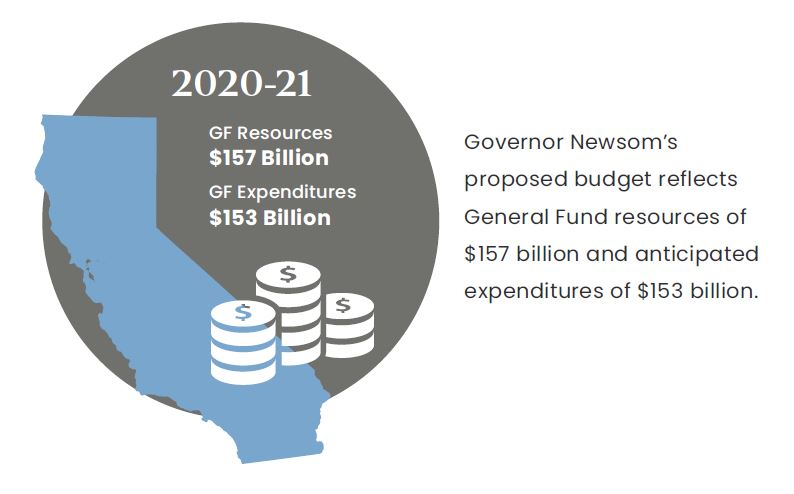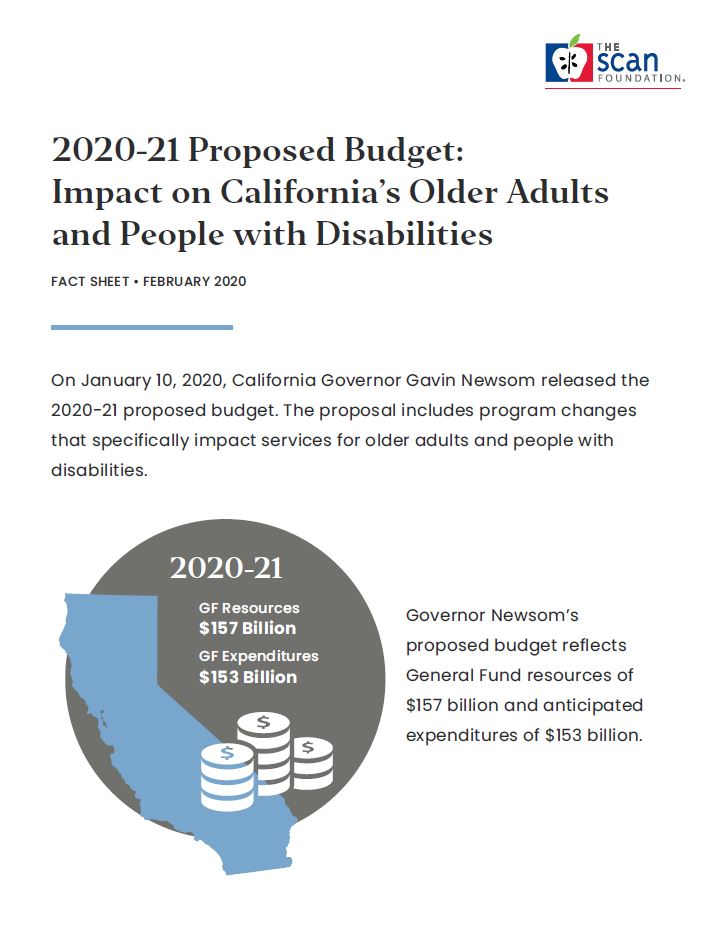2020-21 Proposed Budget: Impact on California’s Older Adults and People with Disabilities
summary
On January 10, 2020, California Governor Gavin Newsom released the 2020-21 proposed budget. The proposal includes program changes that specifically impact services for older adults and people with disabilities.
Date Updated: 02/04/2020Overview
On January 10, 2020, Governor Gavin Newsom released his 2020-21 proposed budget, outlining the state’s projected revenues and spending plan for the fiscal year beginning on July 1, 2020, and ending June 30, 2021. The proposed budget includes total General Fund (GF) resources of $157 billion and anticipated expenditures of $153 billion, with the rest held in reserve. The proposed budget reflects no deficit, a Budget Stabilization Account* balance of $18 billion, a Safety Net Reserve† balance of $900 million, and plans to address the state’s pension liabilities.2,3

Governor Newsom’s 2020-21 proposed budget outlines his top priorities for the year ahead—including addressing homelessness, bolstering emergency preparedness, improving health care access and prescription drug affordability, and other priorities that impact older adults and people with disabilities as outlined below.
Master Plan for Aging
With the planning process still underway, the proposed 2020-21 budget does not outline funding specifically targeted toward the Master Plan for Aging efforts. While many of the governor’s proposed 2020-21 investments address the lives of older adults and people with disabilities, substantial system issues remain that require thoughtful planning, leadership, and additional investments in accordance with the state’s Master Plan efforts.
Governor Newsom’s Executive Order articulated a process and timeline for plan development by October 2020, with the state identifying the following goals to frame the effort:
- Goal 1: Services and Supports. We will live where we choose as we age and have the help we and our families need to do so.
- Goal 2: Livable Communities and Purpose. We will live in and be engaged in communities that are age-friendly, dementia-friendly, and disability-friendly.
- Goal 3: Health and Well-Being. We will live in communities and have access to services and care that optimize health and quality of life.
- Goal 4: Economic Security and Safety. We will have economic security and be safe from abuse, neglect, exploitation, and natural disasters and emergencies throughout our lives.4
We remain hopeful that the October 2020 release of the Master Plan will have corresponding investments that ensure the plan’s goals are realized, thereby ensuring that all Californians have the opportunity to age with dignity and independence.
Budget Proposals Impacting Older Adults and People with Disabilities
The following items reflect proposals that impact California’s older adults and people with disabilities.
Health and Well-Being
Medi-Cal expansion: The governor’s proposed budget includes $80.5 million ($64.2 million GF) to expand full-scope Medi-Cal coverage to all older adults age 65 and older regardless of immigration status beginning no earlier than January 1, 2021.2 Additionally, implementation of the Medi-Cal Aged, Blind, and Disabled Program eligibility expansion to 138 percent of the federal poverty level will be extended to August 1, 2020.2
Building a California for All will need state investments to realize the goals of the Master Plan for Aging.
Medi-Cal Healthier California for All (MCHCA; formerly CalAIM): The fragmented Medi-Cal system is difficult to navigate for individuals with complex care needs, affecting access to medical care, behavioral health, and home- and community-based services to name a few. In an effort to integrate and better coordinate these systems, the California Department of Health Care Services (DHCS) has created the MCHCA initiative which includes enhanced care management and in lieu of services (e.g., housing transition and respite services). DHCS intends to use in lieu of services to develop a MLTSS infrastructure over time to provide needed HCBS services to individuals at risk for institutionalization. It sees the MLTSS infrastructure as a key component of the Master Plan for Aging.5 The proposed budget includes $695 million ($348 million GF) for 2021 growing to $1.4 billion ($695 million GF) for 2021-22 and 2022-23 for implementation.2
Behavioral health: In alignment with MCHCA, the proposed budget includes $45.1 million GF to implement a Behavioral Health Quality Improvement Program, and establishes the Behavioral Health Task Force responsible for improving coordination across all state and county programs.2
Prescription drugs: The proposed budget includes five proposals to reduce prescription drug costs for all Californians, which could help make prescriptions more affordable for older adults and people with disabilities. Proposals include creating a single market for drug pricing within California, and establishing the state’s own generic drug label.2
In-Home Supportive Services (IHSS): The IHSS program provides in-home personal assistance to low-income adults who are age 65 and older, blind, or disabled, and to children who are blind or disabled. Services include assistance with bathing, feeding, dressing, and/or domestic services such as shopping, cooking, and housework so that individuals can remain safely in their own homes. The proposed budget estimates IHSS will serve approximately 586,000 individuals in 2020-21, dedicating $14.9 billion ($5.2 billion GF) for the program.
The budget extends the restoration of the IHSS 7 percent hour reduction to July 1, 2023, and includes funds to address the minimum wage increase for IHSS workers as well as needs assessment training for county social workers and managers to promote consistency across all counties.2,3
Nursing facility financing: The governor’s budget proposes to change the funding framework for nursing homes from one that is predominantly cost-based to one that is value-based, linking payments to quality.2
Veterans services: The California Department of Veterans Affairs operates eight homes throughout the state that provide residential and medical care services to the state’s older and/or disabled veterans. The proposed budget addresses funding shortfalls for three homes, and re-aligns levels of care to address waitlists with interest in the highest level of care.2
Family Caregiving
Paid Family Leave: As of July 1, 2020, the Paid Family Leave (PFL) benefit increases from six to eight weeks. The proposed budget includes steps to align PFL benefits with job protections and resources to support small businesses that offer PFL to their employees.2
California Cognitive Care Coordination Initiative: The proposed budget includes one-time funds of $3.6 million GF to create a coordination and training initiative for family caregivers of people with Alzheimer’s disease or dementia.2
Economic Security
SSI/SSP: In California, the Supplemental Security Income, or SSI (a federal program that provides a monthly cash benefit to low-income aged, blind, and disabled individuals) is augmented with a State Supplementary Payment (SSP) grant. On average, 1.8 million people will receive benefits monthly in 2020-21. In 2020, maximum SSI/SSP grant levels are $943 per month for individuals and $1,583 per month for couples, and are projected to increase by $13 and $20 respectively as of January 2021.2 The proposed budget also includes $25 million GF on an ongoing basis to assist homeless, disabled individuals with applying for SSI/SSP benefits.2
Homelessness: The proposed budget includes $750 million GF one-time funds to establish the California Access to Housing and Services Fund. The fund will be used to provide additional rental subsidies, develop new affordable housing units, and stabilize board and care homes.2
Safety
Consumer Financial Protection Bureau: The proposed budget includes $10.2 million in 2020-21, growing to $19.3 million in 2022-23 to establish and administer the California Consumer Protection Law to protect consumers against exploitation. Specific activities include services to empower and educate consumers, including older adults.2
Data
Center for Data Insights and Innovation: In an effort to leverage data to inform and drive program improvements and system transformation across health and human services, the governor’s budget proposes development of the Center for Data Insights and Innovation which will integrate the existing offices of Innovation, Patient Advocate, and Health Information Integrity.2
Next Steps in the Budget Process
California’s 2020-21 Governor’s Budget requires approval by the Senate and the Assembly prior to being sent to the governor for his signature. Below is a list of key budget dates:
- May 2020 – Release of Governor’s Budget May Revision
- June 15, 2020 – Deadline for Legislature to approve final budget
- July 1, 2020 – Deadline for governor to sign the budget6,7
Download the publication for all visuals and complete references.
Continue Reading
This policy brief provides an introduction to The SCAN Foundation’s CLASS Technical Assistance Brief Series, which explores many of the critical issues to be considered for successfully implementing CLASS.
This policy brief describes the broad needs of individuals with disability and the wide range of supportive and environmental solutions that can allow for the most independent living possible. It suggests how findings on social and environmental supports for individuals with disability can inform implementation of CLASS.
This policy brief provides background on the historical development of benefit eligibility triggers in the private long-term care insurance market. Understanding how these triggers came into being can provide important information to those charged with implementing the CLASS Plan.


